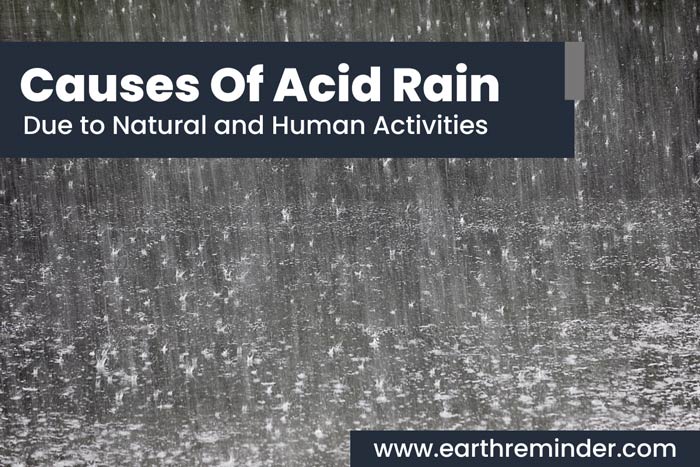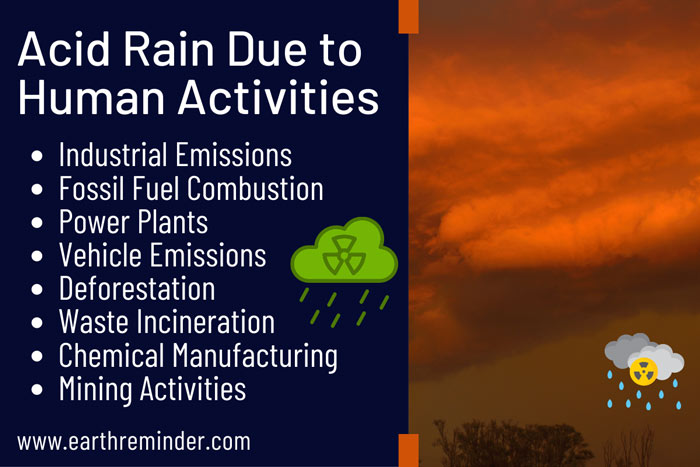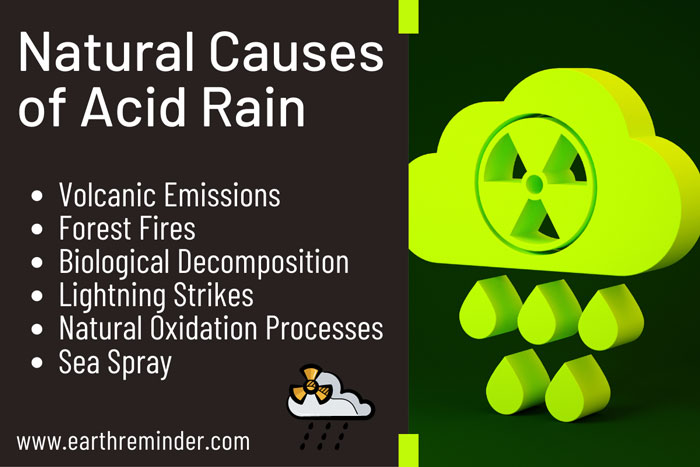Main Causes of Acid Rain: By Natural and Human Activities
We have all known about acid rain since childhood. Acid rain is a serious problem caused by natural and human factors. The high acidity of this precipitation can harm our health, the environment, and even cause corrosion in buildings. When we look at the main causes of acid rain, we can see natural processes and human actions have a role to play. Let’s dive into the details.
Table of Contents
What is Acid Rain?
Acid rain is the extremely acidic rainfall that occurs due to environmental pollution. It is characterized by high levels of nitric acids and sulfur acids. When atmospheric pollution exceeds its limit, it causes acid rain, which significantly damages the environment. There are a number of factors that contribute to acid rain. Some are natural processes, while others are human activities that contribute to acid rain.
In simple terms, acid rain occurs when water droplets become more acidic. The acidity of rainwater is determined by its pH level. Normal rainwater has a pH level of 5.0 to 5.5, which is weakly acidic. When the pH level of water droplets falls below the normal range, it becomes more acidic and leads to acid rain.
Causes Of Acid Rain
Natural processes and human activities both contribute to acid rain. Below are the primary causes of acid rain caused by natural and human activities:
Acid Rain Due to Human Activities
Human activities are the primary cause of acid rain. Activities such as burning fossil fuels and industrial processes cause emission of gases that result in acid rain. Urban areas, which are constantly developing, are particularly affected by acid rain. The main causes of acid rain due to human activities are as follows:
Burning of Fossil Fuels
The burning of fossil fuels, particularly coal, and oil, releases nitrogen oxide (NOx) and sulfur dioxide (SO2) gases into the atmosphere. These two gases are major contributors to acid rain. Fossil fuels are used in various daily activities such as energy generation, heating, and cooking. The combustion of coal and oil pollutes the environment by emitting NOx and SO2.
When these gases are released into the air, they react with water molecules in the atmosphere to form mild sulfuric acid and nitric acid. It is important to note that as the combustion of these fuels increases, so do their emissions into the atmosphere, contributing to acid rain.
Industrial Activities
The industrial revolution led to a significant increase in pollution levels, especially in power plants and the manufacturing industries. Power plants require fuel for energy generation and as we discussed above, the combustion of these fuels releases sulfur dioxide and nitrogen oxide into the atmosphere.
Similarly, manufacturing industries, such as cement manufacturing, chemical production, petroleum refineries, metal production, plastic processing, and pharmaceutical industries, contribute to the emission of NOx and SO2 into the atmosphere.
While efforts have been made in recent years to reduce the emission levels of nitrogen oxides and sulfur dioxide in these industries, continuous and long-term processes can still contribute to acid rain.
Emission From Automobiles
Automobiles have long been a major source of pollution in the environment, and they also contribute to acid rain. With the increase in automobiles and other vehicles over the past few decades, more nitrogen oxide and sulfur dioxide have been released into the atmosphere by them. Acid rain is predominantly observed in urban areas because of high levels of vehicular pollution.
Burning of Waste
Various pollutants are released into the atmosphere when trash and hazardous waste are burned, including sulfur dioxide (SO2) and nitrogen oxides (NOx). When they react with water vapor, they can cause acid rain.
Deforestation
Trees can remove NO2 and SO2 from the air. But when we clear forests for agriculture or urban development, trees lose their natural ability to absorb pollutants from the air. It can lead to increased levels of sulfur dioxide and nitrogen oxides in the air, causing acid rain. It is a fact that preventing deforestation can cure most of the global environmental problems.
Also Read: Deforestation: Causes, Effects, and Preventive Measures.
Natural Causes of Acid Rain
Natural processes also contribute to acid rain, with volcanic eruptions being a prominent example. Pollutants released through natural processes accumulate in the atmosphere over time, increasing the likelihood of acid rain. The following are the natural causes of acid rain:
Volcanic Eruptions
Volcanic eruptions release gases and pollutants that contribute to acid rain. They are a major natural cause of acid rain. Volcanic eruptions release large amounts of gases, such as sulfur. These gases contribute to higher acid rain levels. In some cases, the gases emitted during volcanic eruptions can cause precipitation in the form of fog or snow, which can further negatively affect the Earth’s flora and fauna.
Decomposition Of Biological Processes
There are various biological processes taking place in the environment that cause acid rain. These processes include vegetation decomposition and forest fires. Dimethyl sulfide, a major component released through biological processes, contains sulfur, which is one of the main elements that contribute to acid rain.
Further, a dead plant or animal releases hydrogen sulfide (H2S) and ammonia (NH3) as it decomposes naturally. Nitric acid and sulfuric acid are formed by these gases in the atmosphere, which can further lead to acid rain.
Also Read: Effects of Acid Rain.
Lightning
Lightning naturally contributes to acid rain. When lightning strikes, it releases nitric oxide through a natural process. This nitric oxide reacts with water molecules in the atmosphere through electrical activity. This results in the production of nitric acid through a chemical reaction that rainwater can carry as acid rain.
Forest Fires
The smoke from wildfires releases a lot of nitrogen oxides and sulfur dioxide. When these gases mix with moisture in the air, they can produce nitric acid and sulfuric acid, which can cause acid rain.
Also Read: How Do Wildfires Affect the Environment?
Conclusion
Acid rain is caused by human activities and natural processes that emit sulfur dioxide and nitrogen oxides into the atmosphere. Acid rain effects don’t just stop where pollutant emissions occur. The wind can carry NOx and SO2 very far because they dissolve easily in water, impacting far away places. We need global cooperation to prevent acid rain. It’s a must to keep the environment safe by reducing emissions at their source. Acid rain can be mitigated by reducing emissions, switching to green energy sources, and encouraging global cooperation. Understanding these causes and raising awareness is the first step toward developing effective strategies to prevent acid rain.


